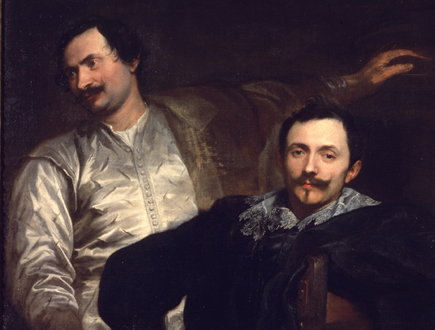
Nov. 2008 — Paris has pulled out all the stops to examine how Picasso looked at and dialogued with the greats that preceded him: Picasso and the Masters at the Grand Palais,Picasso/Delacroix at the Louvre, Picasso/Manet at the Orsay. Heady stuff that gives clues into what Picasso was thinking.
Surveying an extensive exhibit of commissioned portraits by a single artist, whether that artist is Van Dyck or your Aunt Sally, gives rise to the sense that somewhere between artist and subject there is an agreement: I’ll give myself up to you and you’ll do me justice; you give yourself up to my and I’ll do you justice.
hat contractual nod between artist and subject, with its individual nuances, holds center stage in the portraiture of Antoon Van Dyck (1599-1641) presented here, whether he’s capturing on canvas the bourgeoisie in Antwerp, friends and patricians in Italy, colleagues and aristocrats in Spanish Netherlands, or the royal family and Court of England.
I leave it to art historians and exhibit brochures to explain the evolution of Van Dyck’s talent and craft from his work as assistant to Rubens while in his late teens to his work for the Court of England in his late 30s, from his appreciation of earlier artists to his influence on those to come.
Suffice it to say here that his talent was so precocious that he was able fully hold up his end of the artist-subject contract early on in his career and sign with increasingly high nobility.
Above the stiff ruffs and stylish collar lace of his subjects he consistently fulfills his end of the bargain by providing an air of nobility, even goodness to his subjects. For those who have apparently allowed him access to the inner edge of their public world he has graced their portrait with sympathetic if distant warmth. Though these subjects are nearly strangled by their collars, the viewer senses in them their humanity (perhaps Van Dyck’s as well) shining through with glimmers of irony, intelligence, love, peace, or doubt.
Until those subjects are the Court of England.
Knighted by English King Charles I in 1632, Van Dyck set to work as “Principalle Paynter in Ordinarie” to the English royal family and to the Court. There he produced what are the exhibit’s least pleasant portraits to contemplate because while the artist has kept up his end of the bargain his subjects have not. Rather, they wrote the artist-subject agreement in such a way that seemed to say: artist shall present me as a great man/woman/adolescent; subject will allow a certain access.
Only Charles I seems to be aware that his power can actually have an affect on others. At least he was willing to show the artist, or have the artist depict, the fragile edges of power of the man who would hold his throne by divine right. (Charles I was eventually overthrown and executed.) Or did he simply have an endearing face? In any case, Van Dyck has painted not only a king but a man as well.
However, the artist-subject contract with other members of the Court resulted in works that, at least for those presented here, reveal nothing more than title and entitlement. Apparently Van Dyck was commissioned to depict not men, women, and children but simply well-born aristocrats. Standing before these portraits one is nearly tempted to see in them some kind of romantic pensiveness, but their glassy stares and kitsch getups are merely a pose, one that would be considered ridiculous were their titles not so powerful. (Think AIG executives on a hunting trip in the English countryside.) Sure I’m a jerk, these portraits seem to say, but I’m a part of the great enterprise of English aristocracy. Makes you want to smack them.
Unfortunately, the collection ends with those annoying portraits since Van Dyck died soon after, at age 42, before being able to take advantage of an invitation to come to Paris to work for Louis XIII and Prime Minister Richelieu. Not that the French upper-crust would have accepted any less a display of entitlement in their contracts, but their portraits of the time (e.g. by Philippe de Champagne) show them as being less stiff of the upper lip.
Ending the exhibit with a view of the impassive poses of the Court of England leaves a bad taste in the mouth, so I recommend making an about face before the exit so as to revisit the exhibit in reverse. You can then return to less guarded eyes, including the double portrait shown above. Here, painters and art merchants Lucas and Cornelis de Wael, with whom Van Dyck stayed while in Genoa (1627), may appear as a members of a confident elite, however the distinctiveness and combination of their personalities—the one revealed in cavalier, nearly mocking, wisdom, the other in brisk, intense seduction—shows the depth, fertility, and balance of that artist-subject(s) contract.
Nearby is the most curious contract of all, that between artist as artist and artist as subject: Self-portrait. Though Van Dyck did many during his career this is the only one in the exhibit. Painted when he was 22 or 23 years old, it shows a man impressively young for his accomplishments, surprisingly dandy for his ability, a young man confident that he had the talent and wherewithal to negotiate with the best of them.
Van Dyck Exhibit
Until January 25, 2009.
Open daily 10am-6pm, Mon. until 9:30pm.
10€, includes entrance and audioguide to permanent collection.
Musée Jacquemart-André
158 boulevard Haussmann
75008 Paris
Metro: Miromesnil or St Philippe du Roule
www.musee-jacquemart-andre.com
© 2008, Gary Lee Kraut

